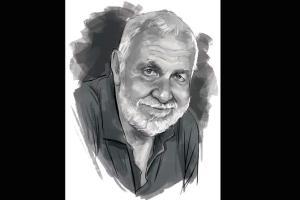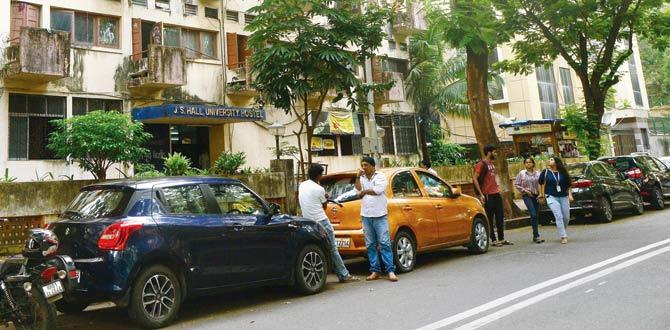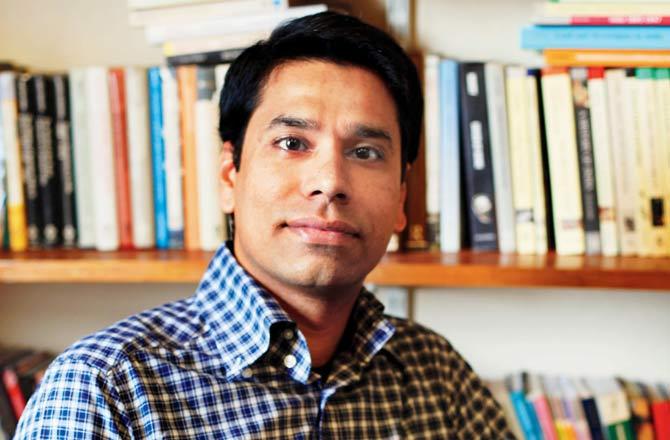A new collection of essays by scholars united in praise for Jim Masselos reveals the significance of a Bombay lover and researcher who mined deep into the city's archives to share untold stories

Jim Masselos. Illustration/Uday Mohite
The 1950s and '60s were a time to travel, Australian scholar James Cosmas Masselos writes in an essay. But while most of his friends were moving to Europe, to create their own version of the grand European dream, Masselos says his "path stopped at Bombay".
ADVERTISEMENT
A young researcher in his early 20s then, he had been awarded a commonwealth scholarship—first to be nominated from Australia—by the Indian government to Pursue a PhD in history at St Xavier's College, University of Bombay (later Mumbai). "Bombay was... for me, long strips of roadways, barely illuminated by the sporadic sprinkle of naked electric lights on streetside huts," he shares of the first snatches he saw of the city, after he had landed. Little did he know, that he'd go on to become its indefatigable chronicler. A new book, Bombay Before Mumbai (Penguin Random House), edited by academicians Prashant Kidambi, Manjiri Kamat and Rachel Dwyer, honours the pioneering researcher and his work on the city, with a collection of essays contributed by 14 scholars from across the world.

Jim Masselos says his understanding of urban spaces began with the University Hostel, now called Jagannath Sunkersett Hall University Hostel, where he lived with students from diverse backgrounds in the 1960s. Pic/Suresh Karkera
"These essays were first presented at a two-day international conference at Mumbai University's department of history in January 2017," says Kidambi, historian and associate professor of colonial urban history at the University of Leicester, in an email interview to this paper. Split into four themes—community, space, power and nationalism—the contributors take us through Masselos's oeuvre. "I first encountered Jim Masselos on the page," recalls Kidambi, adding, "His writings were essential reading for me when I began my doctoral research on colonial Bombay. I think what is distinctive about his oeuvre is its specific combination of the archival and the conceptual. That is to say, he mines deep in the archive and finds stories that have been buried within. But he is not simply interested in facts for their own sake or as an antiquarian pursuit. He has developed analytical models that have proved productive for those who have followed him."
Masselos began his research in 1961, focussing on first-generation Western educated Indians from the city. Parsi reformers and politicians such as Dinshaw Edulji Wacha, Naoroji Furdunji, Pherozeshah Mehta, trader Mohammad Ali Rogay and writer Lakshmibai Tilak were among those who made it to his list. "They set up the parameters for intellectual, critical thinking [in the city]. For them it must have been an extraordinary time, because they were being exposed to a whole new world of ideas; they were in touch with the Europeans in Bombay and those in Britain. I researched the changes that were occurring [through them] and how they sowed the seeds of nationalism by starting several associations in the city, even before the Congress happened," says Masselos, over a telephonic interview from Australia. According to Kidambi, this is also what made his work on Mumbai, seminal. "His writings show how Bombay was made not from above by its rulers, but from downward up by its inhabitants. This may seem self-evident today, but it was not so when he first began writing. For, at that time, scholars still tended to view the 'colonial city' as something that was the product primarily of European agency."

Prashant Kidambi, historian
The scholar-researcher continued to engage with the city through the 1970s and '80s, with writing that explored urban mohallas to crowds, popular culture and the role of the Gandhian Congress in mobilisation of the masses. "He highlighted how Bombay was simultaneously one and many worlds," Kidambi says. Historian Jesse S Palsetia, who has contributed an essay, mentions how in 1974, Masselos "noted a pattern of community development in Bombay, which he referred to as 'integration and encapsulation'". The pattern involved "communities and groups coexisting within the broader fabric of the city's life, while safeguarding their unique community and caste interests," he writes.
Forty-five years on, Masselos says that these communities continue to give the city its character. "You still have Muslim and Christian neighbourhoods and Parsi enclaves. And even if these residents move out, these areas will continue to be associated with those particular social groups."
Another area that occupied his work was the role of urban spaces within the city. Masselos's own understanding of spaces began with the University Hostel (now Jagannath Sunkersett Hall University Hostel) where he lived with students from diverse backgrounds. The subsequent riots that followed, saw him analyse minority groups and their relationship with different neighbourhoods.
In the book, Kidambi cites an essay that Masselos wrote on the first major Hindu–Muslim riots of August 11, 1893, which illustrated how "quotidian spaces could be swiftly transformed by a cataclysmic event". Masselos shared the account of a Hindu clerk named Bhasker Madhow Sett, who was on his way home, when he found himself in the thick of rioting men. He took shelter in Gosavipura, a locality inhabited by scavengers, where two women, "hid him for five hours under a charpoy". He later disguised himself as a woman and made his way to the house of a Parsi friend in Khetwadi, who "gave him another guise, that of a Parsi" and escorted him home. "During his odyssey through the streets of Bombay, Madhow Sett metaphorically changed his class and gender, to say nothing of taking on two different religions in as many hours," the scholar had observed.
"Usually, riots [in Bombay] occurred in one locality, but the one in 1992-93 spread through the whole city," Masselos shares now. "Everyone said then, that Bombay would never be the same again." While the city did heal, its neighbourhoods would go on to change drastically. "I suppose, as Mumbai gets richer and the supply of housing improves, the city will be better equipped to cope with social tensions," he says.
He, however, rues about disappearance of some "core elements" that defined the city. The cotton mills, for instance. "Though, they are slowly making way for highrises, what remains to be seen is whether they are going to be an economic equivalent to the mills in a decade's time." Over the years, Masselos's love for Mumbai has only grown. He visits the city at least once a year, "living as a detective" in its libraries, poring over reams of archival material. There is also one more reason to keep coming back. "It has the world's most magnificent sunset."
Catch up on all the latest Mumbai news, crime news, current affairs, and also a complete guide on Mumbai from food to things to do and events across the city here. Also download the new mid-day Android and iOS apps to get latest updates
 Subscribe today by clicking the link and stay updated with the latest news!" Click here!
Subscribe today by clicking the link and stay updated with the latest news!" Click here!






